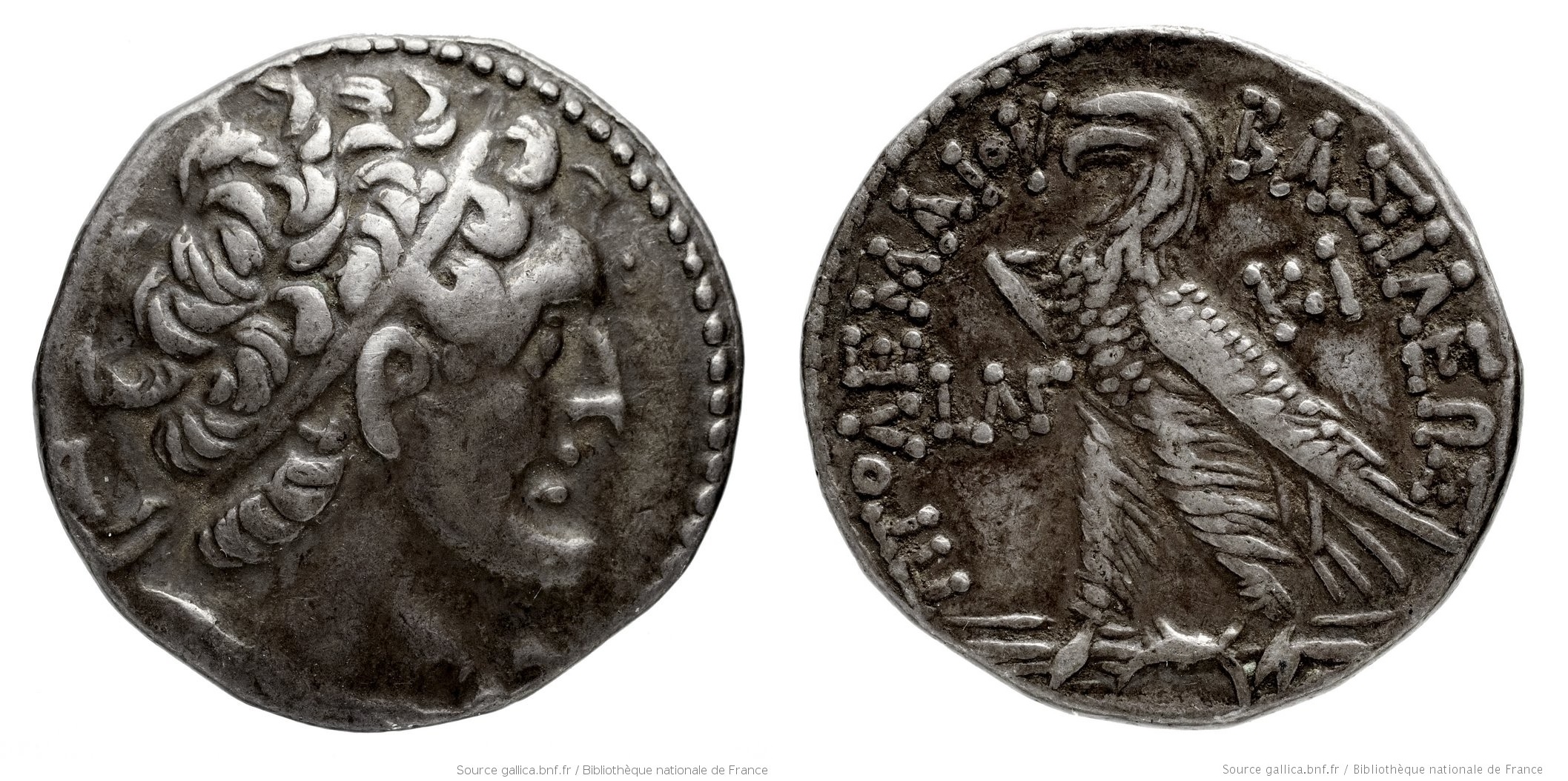S 611 - Salamis (Ptolemy VI), silver, tetradrachms (180-170 BCE)
From SILVER
180 BCE - 170 BCE Silver 3,796 kg
Description
| ObverseInscription or printing placed on the obverse.: | Head of Ptolemy I Soter to right, wearing diadem and aegis around neck. |
| ReverseInscription or printing placed on the reverse.: | ΠΤΟΛΕΜΑΙΟΥ ΣΟΤΗΡΟΣ (Greek).Eagle standing to left on thunderbolt. In field, date and 1) pilei and a diademed petasos or a thyrsos, 2) Isis crown (and a star) or 3) Horus crown. |
Mint and issuing power
| MintIdentifies the place of manufacture or issue of a numismatic object.: | Salamis | Ancient regionAncient region.: | Cyprus | Modern countryModern country: Turkey | AuthorityIdentifies the issuing power. The authority can be "pretended" when the name or the portrait of X is on the coin but he/she was not the issuing power. It can also be "uncertain" when there is no mention of X on the coin but he/she was the issuing power according to the historical sources: | Ptolemaic dynasty (323-30 BC), Ptolemy VI Philometor (Ptolemaic king, 180-145 BC) |
Chronology
| FromIdentifies the initial date in a range assigned in a numismatic context. | 180 BCE | toIdentifies the final date in a range assigned in a numismatic context.. | 170 BCE | PeriodTime period of the numismatic object.: Hellenistic 323-30 BC |
Physical description
| MetalThe physical material (usually metal) from which an object is made.: | Silver |
Median weightMedian of the weights of numismatic objects (in grams). in grams | 14.10 | DenominationTerm indicating the value of a numismatic object. Examples: tetradrachm, chalkous, denarius.: | tetradrachm |
StandardStandard.: | Ptolemaic |
Image

S 611 Salamis Ptolemy VI Tetradrachm 180-170.jpg [1]
References
| Die study referencePublication of the study: | Olivier 20121Olivier 2012, p. 60-79, n° 243-299. | ||
| Coin series referenceReference to coin series study: | |||
Obverse dies distribution
| FrequencyFrequency of specimen in distribution. ᵖ | Number of obversesNumber of obverse dies. ᵖ (o) | % (o) | Number of coinsNumber of coins. (n) | % (n) | Die nameName(s) of the die(s). |
| 1 | 5 | 41.67 | 5 | 8.77 | 52, 57, 58, 59, 62 |
| 2 | 1 | 8.33 | 2 | 3.51 | 55 |
| 3 | 2 | 16.67 | 6 | 10.53 | 51, 61 |
| 6 | 1 | 8.33 | 6 | 10.53 | 53 |
| 10 | 1 | 8.33 | 10 | 17.54 | 60 |
| 14 | 2 | 16.67 | 28 | 49.12 | 54, 56 |
| Total | 12 of 12 | 100 | 57 of 57 | 100 |
Reverse dies distribution
no distribution is available
Quantification
| Number of obversesNumber of obverse dies. ᵖ (o) | 12 | Number of singletons (o1)The number of singleton coins. ᵖ | 5 |
| Number of reverse diesNumber of reverse dies. (r) | 28 | Number of coinsNumber of coins. (n) | 57 |
| Coins per obverse dieNumber of coins per obverse die. (n/o) | 4.75 | Coins per reverse dieNumber of coins per reverse die. (n/r) | 2.04 |
| Reverse per obverse ratioRatio of obverse dies divided by reverse dies. (r/o) | 2.33 | Percentage of singletons (o1)number of coins (n) divided by the number of singletons (o1) ᵖ | 41.67 % |
| Original number of dies (O) (Carter 1983 formula)The estimation of the number of coins according to Carter 1983 ᵖ | 13.46 | Coins struck if 20,000 as average productivity per dieCoins made if the average productivity for obverses (according to Carter) is 20,000. ᵖ | 269,200 |
| Original number of dies (O) (Esty 2011 formula)The estimation of the number of coins according to the singleton formula in Esty 2011 ᵖ (O) | 15.2 | Survival rate if 20,000 as average productivity per dieSurvival rate if average productivity is 20,000. ᵖ | 0.00021 |
| Coverage (o = % of O) (Esty 1984 formula)Esty 1984 - coverage (% of O) ᵖ (o = % of O) | 91.23% | Die productivity if survival rate 1/2,000Average productivity if survival rate is 1/2,000. ᵖ | 8,469.54 |
| Weight of silver (in kg) if 20,000 coins per die (O = Carter formula)Carter 1983 * Median weight * 20000 (*10 if gold or electrum) ᵖ | 3,796 kg <br /> 3,796 kg | Die productivity if survival rate 1/5,000Average productivity if survival rate is 1/5,000. ᵖ | 21,173.85 |
Remarks
Likely military
References
- ^ Olivier, Julien (2012), Archè et Chrèmata en Egypte au IIe siècle avant J.-C. (204-81 av. J.-C.). Etude de numismatique et d'histoire, [Unpublished doctoral dissertation], Orléans University, 2012.